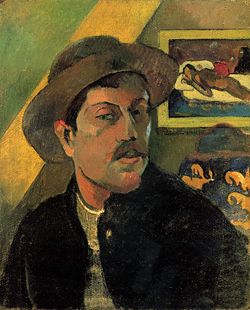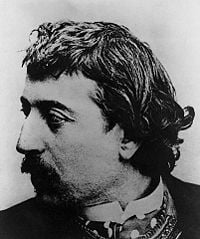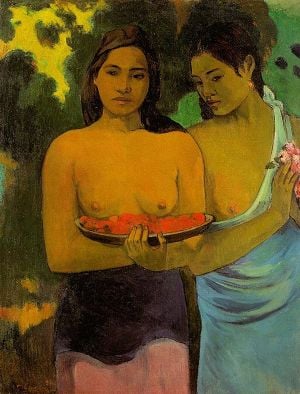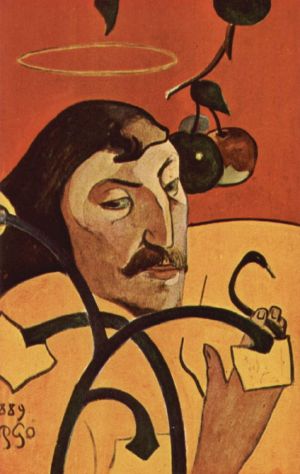Paul Gauguin
EugĂšne Henri Paul Gauguin (June 7, 1848 â May 9, 1903), also spelled Gaugin, was a leading Post-Impressionist artist. Best known as a painter, his bold experimentation with coloring led directly to the Synthetist style of Modern Art, while his expression of the inherent meaning of the subjects in his paintings paved the way to Primitivism and the return to the pastoral. He was also an influential exponent of wood engraving and woodcuts as art forms.
Separating from his wife and five children and suffering from bouts of depression, Gauguin became increasingly focused on his art, associating with such Parisian artists as Camille Pissarro and Paul CĂ©zanne. The mystic symbolism and vigor he found in Asian and African art, along with his interest in cloisonne-enameling, influenced his style. Destitute and seeking recognition, Gauguin left his native France, eventually settling in Polynesia. Full of quasi-religious symbolism and an exoticized view of the islanders, his intensely colorful paintings today command tens of millions of dollars among art collectors.
Gauguin was a major influence on a wide variety of younger artists, and his impact has been observed on styles ranging from Fauvism to Expressionism, Cubism, and the Arts and Crafts Movement.
Life and Work
Paul Gauguin was born in Paris, France to journalist Clovis Gauguin and Aline Maria Chazal, the half-Peruvian daughter of a socialist activist. In 1851, the family left Paris for Peru, motivated by the political climate of the period. Clovis died on the voyage, leaving three-year-old Paul, his mother, and his sister to fend for themselves. They lived for four years in Lima, Peru with Paul's uncle and his family. The imagery of Peru would later influence Gauguin in his art.
At the age of seven, Paul and his family returned to France to live with his grandfather in Orléans. He soon learned French and excelled in his studies. At 17, Gauguin signed on as a pilot's assistant in the merchant marine to fulfill his required military service. Three years later, he joined the navy where he stayed for two years. In 1871, Gauguin returned to Paris where he secured a job as a stockbroker. In 1873, he married a Danish woman, Mette Sophie Gad. Over the next 10 years, they would have five children.
Gauguin had been interested in art since his childhood. In his free time, he began painting and would also frequent galleries and purchase many of the new art coming out in Paris. He formed a friendship with Camille Pissarro, who introduced him to various artists through his connections. As he progressed in his art, Gauguin rented a studio, and showed paintings in Impressionist exhibitions held in 1881 and 1882. Over two summer vacations, he painted with Pissarro and occasionally with Paul CĂ©zanne.
By 1884, Gauguin had moved with his family to Copenhagen, where he unsuccessfully pursued a business career. Driven to paint full-time, he returned to Paris in 1885, leaving his family in Denmark. Without adequate subsistence, his wife and their five children returned to her family.
Like his friend Vincent Van Gogh, with whom he spent nine weeks painting in Arles, Gauguin experienced bouts of depression and at one time attempted suicide. Disappointed with Impressionism, he felt that traditional European painting had become too imitative and lacked symbolic depth. By contrast, the art of Africa and Asia seemed to him full of mystic symbolism and vigor. There was a vogue in Europe at the time for the art of other cultures, especially that of Japan. Gauguin was invited to participate in the 1889 exhibition organized by Les XX.[1].
Under the influence of folk art and Japanese prints, Gauguin evolved towards Cloisonnism, a style given its name by the critic Ădouard Dujardin in response to Emile Bernard's cloisonne-enameling technique. Gauguin was very appreciative of Bernard's art and of his daring with the employment of a style which suited Gauguin in his quest to express the essence of the objects in his art. In The Yellow Christ (1889), often cited as a quintessential cloisonnist work, the image was reduced to areas of pure color separated by heavy black outlines. In such works, Gauguin paid little attention to classical perspective and boldly eliminated subtle gradations of colorâthus dispensing with the two most characteristic principles of post-Renaissance painting. His painting later evolved towards "synthetism," in which neither form nor color predominate but each has an equal role.
Gauguin made several attempts to find a tropical paradise where he could "live on fish and fruit" and paint in his increasingly primitive style. Including short stays in Martinique and as a worker on the Panama Canal. In 1891, frustrated by lack of recognition at home and financially destitute, Gauguin sailed to the tropics to escape European civilization and "everything that is artificial and conventional." Living in Mataiea Village in Tahiti, he painted "Fatata te Miti" ("By the Sea"), "La Orana Maria" (Ave Maria), and other depictions of Tahitian life. He moved to Punaauia in 1897, where he created the masterpiece painting "Where Do We Come From," and then lived the rest of his life in the Marquesas Islands, returning to France only once.
His works of that period are full of quasi-religious symbolism and an exoticized view of the inhabitants of Polynesia, where he clashed often with the colonial authorities and the Catholic Church. During this period, he also wrote the book Avant et AprĂšs ("Before and After"), a fragmented collection of observations about life in Polynesia, memories from his life, and comments on literature and paintings. In 1903, charged with libel against the governor, he was sentenced to three months in prison and fined. At the time, he was being supported by an art dealer.
In 1903 at age 54, Gauugin died of syphilis before he could start the prison sentence. His body had been weakened by alcoholism and a dissipated life style. He is buried in Calvary Cemetery (CimetiĂšre Calvaire), Atuona, Hiva âOa, Marquesas Islands, French Polynesia.
Quotations
- In order to do something new we must go back to the source, to humanity in its infancy.
- How do you see this tree? Is it really green? Use green, then, the most beautiful green on your palette. And that shadow, rather blue? Don't be afraid to paint it as blue as possible.
- To me, barbarism is a rejuvenation.
- I have tried to make everything breathe in this painting: belief, passive suffering, religious and primitive style, and the great nature with its scream.
- Art is either plagiarism or revolution.
- I shut my eyes in order to see.
- Life being what it is, one dreams of revenge.
- How long have I been here? Hence, foreward, for I shall not know. For I have been traveling for too long. My bones too weary to remember my age. Hence, how long have I been here? Thou shalt never know.
Legacy
The vogue for Gauguin's work started soon after his death. Many of his later paintings were acquired by the Russian collector Sergei Shchukin. A substantial part of his collection is displayed in the Pushkin Museum and the Hermitage. Gauguin's paintings are rarely offered for sale; their price may be as high as $39.2 million.
Gauguin had an impact on many other painters, his contemporaries CĂ©zanne and van Gogh among them. Several younger artists of the Nabis group were inspired by Gauguin's ideas. The Fauvists were also strongly influenced by him, Henri Matisse in particular. His artistic experiments influenced many developments in early twentieth century painting. Edvard Munch's use of line has been traced to Gauguin's style. Expressionists such as Ernst Ludwig Kirchner were also influenced by him, as was the young Pablo Picasso. Another notable connection is his imparting to Arthur Frank Mathews the use of an intense color palette. Mathews, who Gauguin in the late 1890s while both were at the Academie Julian, took this influence in his founding of the California Arts and Crafts (or California Decorative) movement.
The Japanese-styled Gauguin Museum, opposite the Botanical Gardens of Papeari in Papeari, Tahiti, contains exhibits, documents, photographs, reproductions, and original sketches and block prints of and by Gauguin. In 2003, the Paul Gauguin Cultural Center opened in Atuona in the Marquesas Islands.
Gauguin's life inspired Somerset Maugham to write The Moon and Sixpence.
Gallery
Notes
- â Les XX was a group of twenty Belgian painters, designers and sculptors, formed in 1883 by the Brussels lawyer, publisher, and entrepreneur, Octave Maus. For ten years these "vingtistes," as they called themselves, held an annual exhibition of their art; each year twenty international artists were also invited to participate in the exhibition. Artists invited over the years included: Camille Pissarro (1887, 1889, 1891), Claude Monet (1886, 1889), Georges Seurat (1887, 1889, 1891, 1892), Paul Gauguin (1889, 1891), Paul CĂ©zanne (1890), and Vincent van Gogh (1890, 1891).
ReferencesISBN links support NWE through referral fees
- Barskaya, Anna. 2005. Paul Gauguin. Grange Books. ISBN 9781840135657
- Dorra, Henri. 2007. The Symbolism of Paul Gauguin: Erotica, Exotica, and the Great Dilemmas of Humanity. University of California Press. ISBN 9780520241305
- Flux, Paul. 2002. Paul Gauguin. Heinemann Library. ISBN 9780431092164
- Gauguin, Paul, Claire Freches-Thory (Author), and George Shackelford (Contributor). 2004. Gauguin Tahiti. MFA Publications. ISBN 9780878466665
External links
All links retrieved November 21, 2022.
Credits
New World Encyclopedia writers and editors rewrote and completed the Wikipedia article in accordance with New World Encyclopedia standards. This article abides by terms of the Creative Commons CC-by-sa 3.0 License (CC-by-sa), which may be used and disseminated with proper attribution. Credit is due under the terms of this license that can reference both the New World Encyclopedia contributors and the selfless volunteer contributors of the Wikimedia Foundation. To cite this article click here for a list of acceptable citing formats.The history of earlier contributions by wikipedians is accessible to researchers here:
The history of this article since it was imported to New World Encyclopedia:
Note: Some restrictions may apply to use of individual images which are separately licensed.






















